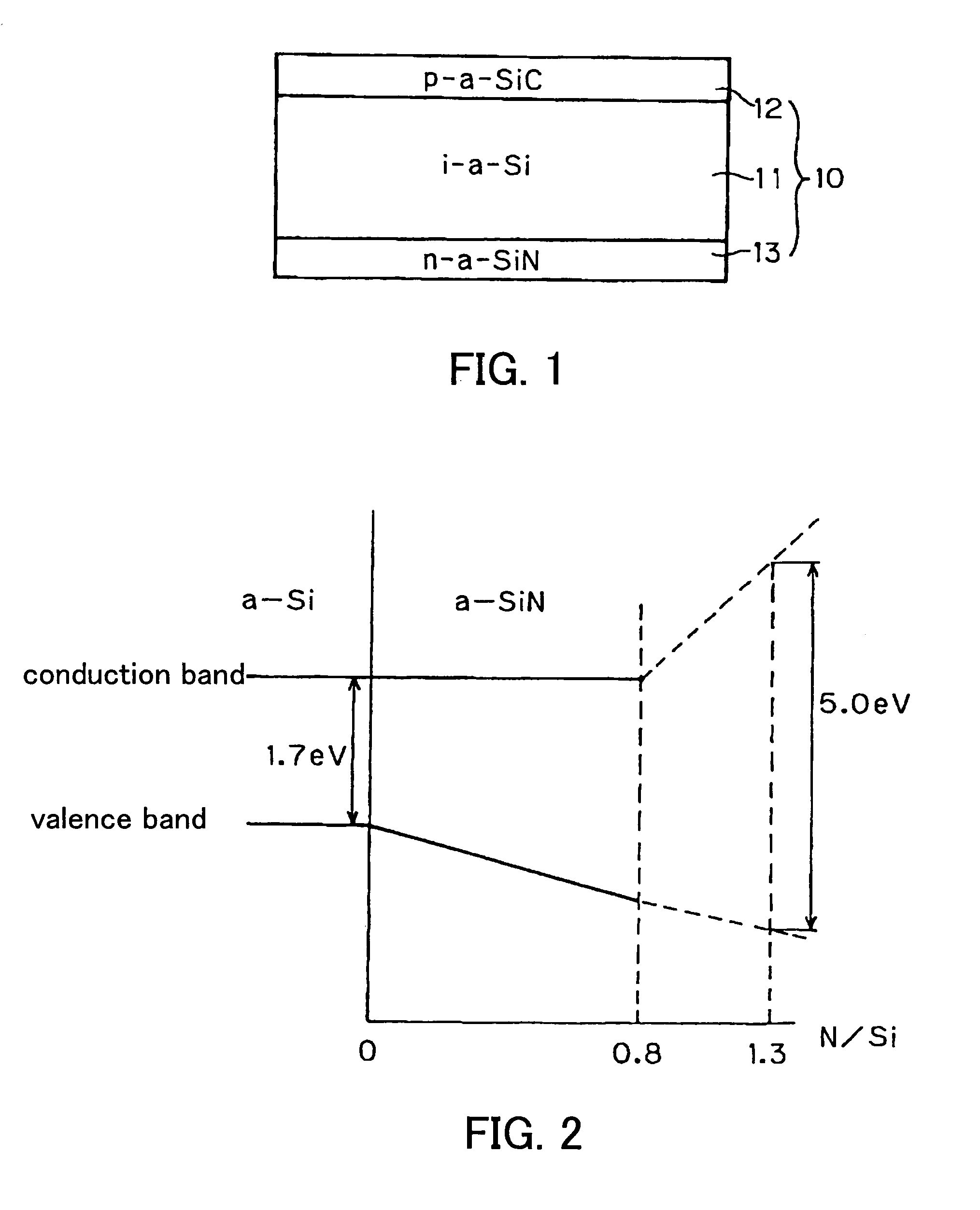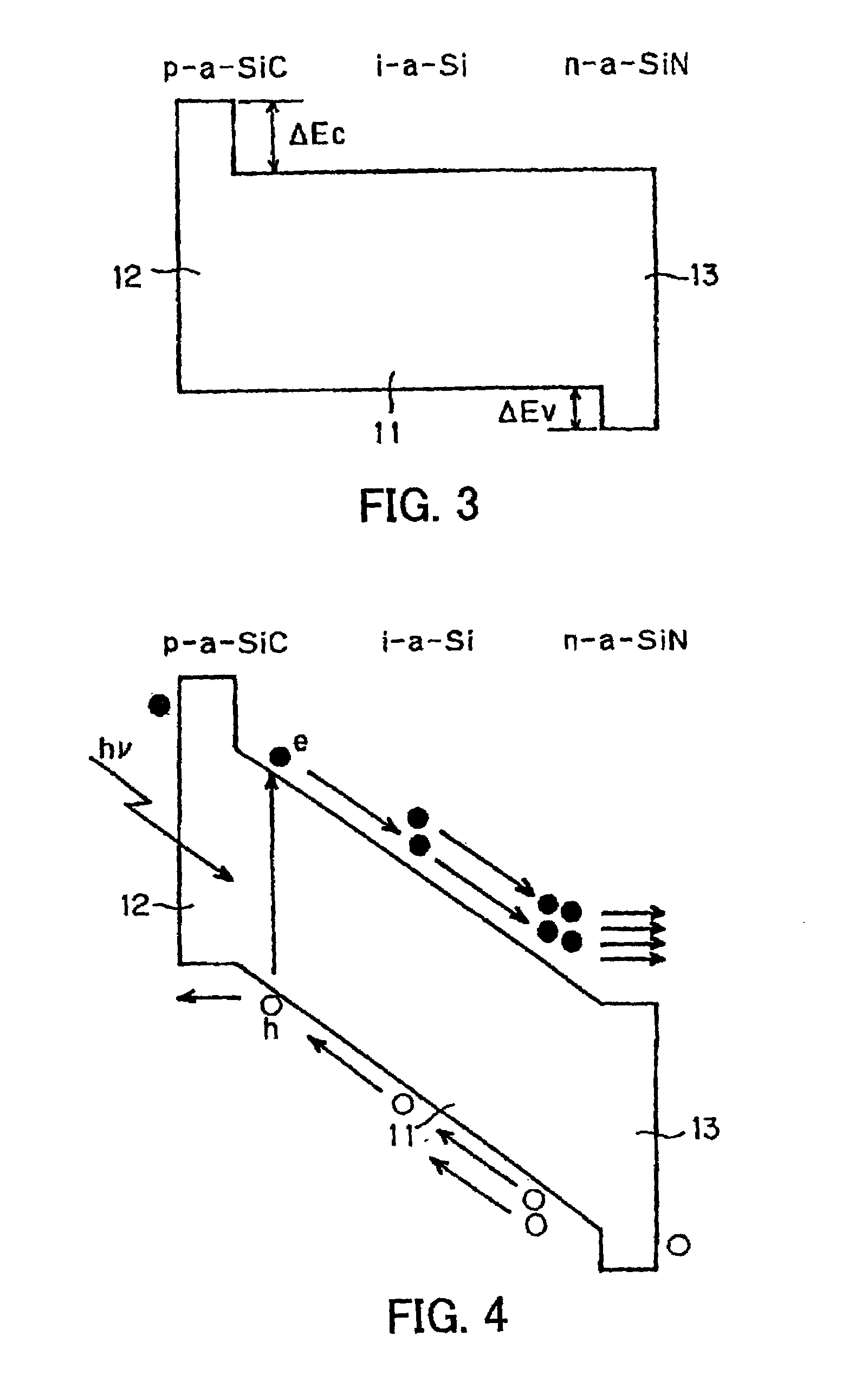Photoelectric conversion device and solid-state image sensing device using the same
a conversion device and solid-state image technology, applied in the direction of material analysis, radiation control devices, instruments, etc., can solve the problems of large number of defects produced at the interface, dark current, etc., to prevent electrons, facilitate the planarization of the substrate surface, and prevent the peeling off of the injection inhibiting layer
- Summary
- Abstract
- Description
- Claims
- Application Information
AI Technical Summary
Benefits of technology
Problems solved by technology
Method used
Image
Examples
first embodiment
[0047]A cross section of a photoelectric conversion device 1 of the first embodiment is shown diagrammatically in FIG. 5. The photoelectric conversion device 1 is obtained by forming the three-layered structure 10 on a substrate 21 made of monocrystalline silicon. The silicon substrate 21 is of n-type and the n-a-SiN hole injection inhibiting layer 13 is in contact with the silicon substrate 21. A transparent electrode 22 made of gold (Au) is provided on the p-a-SiC electron injection inhibiting layer 12.
[0048]The following is a specific example of a method of fabricating the photoelectric conversion device 1. First, the n-type silicon substrate 21 is placed in a deposition chamber of a capacitively-coupled parallel-plate plasma CVD system and heated by a heater such that the temperature of the substrate 21 is increased to 250° C. Then, the deposition chamber is sufficiently vacuumed so that a silane gas diluted to 10% with hydrogen, an ammonia gas diluted to 10% with hydrogen, and ...
second embodiment
[0055]A cross section of a photoelectric conversion device 2 of a second embodiment is shown diagrammatically in FIG. 7. The photoelectric current conversion device 2 is formed by using a p-type monocrystalline silicon for a substrate 23 such that the p-a-SiC electron injection inhibiting layer 12 is in contact with the silicon substrate 23. A transparent electrode 24 made of ITO is provided on the n-a-SiN hole injection inhibiting layer 13.
[0056]The photoelectric conversion device 2 is fabricated by forming the electron injection inhibiting layer 12, the carrier generation / multiplication layer 11, the hole injection inhibiting layer 13, and the transparent electrode 24 in this order. Since only the order in which the layers are formed is different and the processes in the individual steps are the same as described in the example of the fabrication of the photoelectric conversion device 1, the overlapping description will be omitted.
[0057]The photoelectric conversion device 2 of the...
third embodiment
[0058]A cross section of a solid-state image sensing device 3 of a third embodiment is shown diagrammatically in FIG. 8. The solid-state image sensing device 3 is of CCD type and has the three-layered structure 10 as a photoelectric conversion unit provided on a multilayer structure. FIG. 8 indicates a range containing one pixel in the solid-state image sensing device 3.
[0059]The following is a specific example of a method of fabricating the solid-state image sensing device 3. First, a p+-type device isolation region 32 is provided in the p-type silicon substrate 31 and an accumulation diode 33 composed of an n+-type impurity region is formed in the area surrounded by the p+-type device isolation region 32. An n-type channel region 34 of a vertical CCD is provided adjacent the accumulation diode 33. Subsequently, a first insulating film 35 is formed of a silicon oxide film over the entire top surface of the substrate 31. During the formation of the insulating film 35, transfer gate ...
PUM
 Login to View More
Login to View More Abstract
Description
Claims
Application Information
 Login to View More
Login to View More - R&D
- Intellectual Property
- Life Sciences
- Materials
- Tech Scout
- Unparalleled Data Quality
- Higher Quality Content
- 60% Fewer Hallucinations
Browse by: Latest US Patents, China's latest patents, Technical Efficacy Thesaurus, Application Domain, Technology Topic, Popular Technical Reports.
© 2025 PatSnap. All rights reserved.Legal|Privacy policy|Modern Slavery Act Transparency Statement|Sitemap|About US| Contact US: help@patsnap.com



